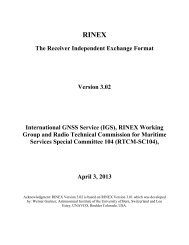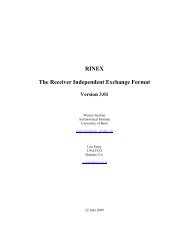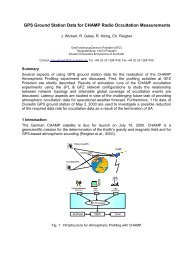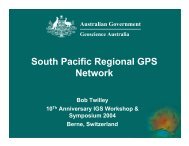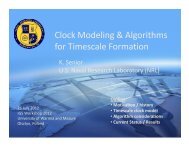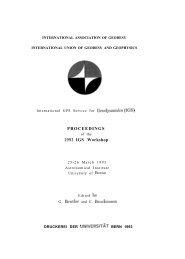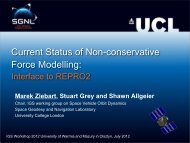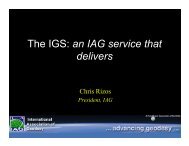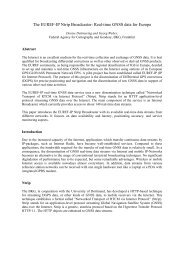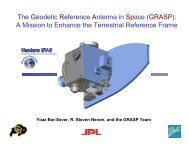IGS Analysis Center Workshop - IGS - NASA
IGS Analysis Center Workshop - IGS - NASA
IGS Analysis Center Workshop - IGS - NASA
Create successful ePaper yourself
Turn your PDF publications into a flip-book with our unique Google optimized e-Paper software.
adiation parameters for each satellite). They found that ambiguity resolution was notpossible in the PGGA until after the combination of orbital elements, and that the resultinglong-term repeatability of PGGA baseline coordinates was 3 mm in the north, 5 mm in theeast, and 8 mm in the vertical. These number are actually representative of the level ofprecision obtained today with a full simultaneous regionallglobal network solution.There are many combinations of adjustments that are possible in this scenario; we havepresented one example. The only involvement of the <strong>IGS</strong> analysis center in this scenario isthe passive role of making available (e.g., via anonymous ftp) the data and solutions to oneof the regional analysis centers.Scenario 4. The <strong>IGS</strong> has grown to 200 globally distributed stations. No analysis center iscapable or willing to analyze all of these stations on a regular basis. The decision is madeto distribute the processing load to several centers with overlapping stations. Each centerproduces a set of solution files which are adjusted at one analysis center to produce a singlesolution for all of the active stations, including one set of orbits, one set of earth orientationvalues and one set of station coordinates. The regional clusters are free to choose anycombination of clean global tracking data and solution files from the analysis centers.Using the same approach as outlined in scenarios 3 and 4, the solution files from allanalysis centers and regional clusters can be integrated at chosen intervals to produce aconsistent set of coordinates (and velocities) for all stations with respect to the ITRF.4.5 Distributed <strong>Analysis</strong>: ComplicationsIn all of the above examples from S10 the same analysis software (GAMIT/GLOBK) wasused so that the solution files were generated with the same physical models and usingorbital arcs and earth orientation values consistent with the <strong>IGS</strong> analysis performed daily atS10. As long as the physical models (more specifically the partial derivatives in GAMITused to form the normal equations) are not changed, the solution files from thousands ofsolutions and hundreds of stations can be re-analyzed with GLOBK in a very efficientmanner. A change in the physical models (e.g., new parameterization of zenith delayparameters) requires that the solution files be re-generated with GAMIT. This is a fairlyformidable task but can be done efficiently on state-of-the-art scientific workstations in abatch run, particularly if the individual solutions contain a manageable number of stations,which at the current state of the art is about 30-35. Since the clean RINEX files areavailable from earlier solutions there is no longer any data editing required.As we have described in the earlier sections there are a number of complications ingeneralizing this approach and making it uniformly rigorous, for example: how to integratethe analyses of various regional and global analysis centers using different softwarepackages, particularly when producing solution files with orbital parameters; how to avoidmultiple use of data but preserve the connection to the global reference frame; how toproperly weight solution files; how to check consistency of the solution files prior tocombination.5. Broad RecommendationsSpecific recommendations for integrating the <strong>IGS</strong> global network and regional clustershave been presented in this paper. Here we summarize a series of broad recommendations.(i) <strong>IGS</strong> adopt the concept of Regional <strong>Analysis</strong> <strong>Center</strong>s (RAC’S) for the processing ofregional clusters, and Network <strong>Analysis</strong> <strong>Center</strong>s (NAC’s) for the combination of networksolutions, and incorporates such centers into its structure. The details of “membership”.88




